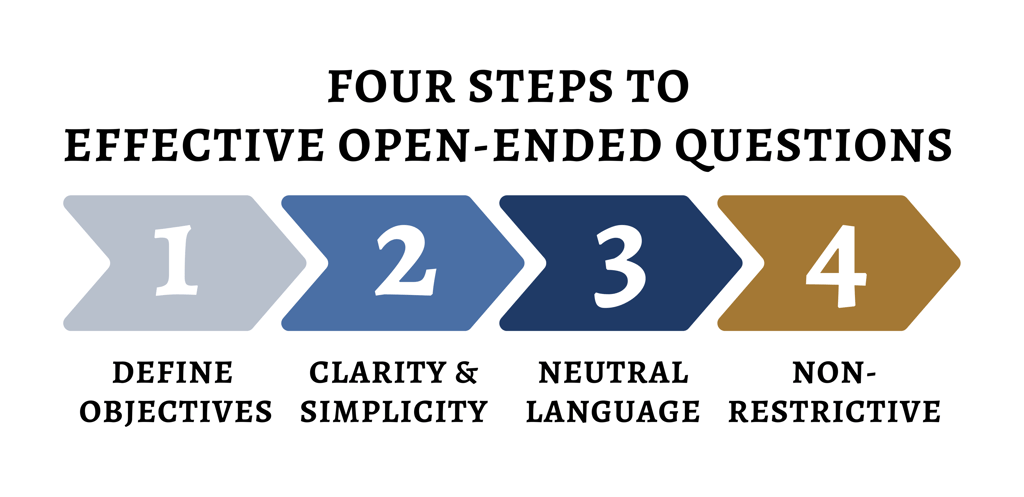Save $400 on your edit with the Preferred Client Value Package! Hurry—space is limited!
Writing Effective Open-Ended Questions for Interviews, Focus Groups, and Questionnaires
4 min read


Open-ended questions are a cornerstone of qualitative research, enabling participants to share detailed, nuanced responses that provide rich insights. Whether for interviews, focus groups, or questionnaires, crafting effective open-ended questions is essential for gathering meaningful data. However, poorly designed questions can lead to confusion, incomplete answers, or biased responses. This guide will explore how to write practical open-ended questions, common pitfalls to avoid, and tips for refining your approach. By mastering the art of these questions, you can uncover deeper perspectives and ensure that your research captures the complexity of participant experiences.
What Are Open-Ended Questions?
Open-ended questions are inquiries that encourage respondents to elaborate and provide detailed answers in their own words. Unlike closed-ended questions, which limit responses to predefined options (e.g., yes/no or multiple-choice), open-ended questions allow for a broader range of insights and uncover perspectives you might not have considered. These questions are vital for exploring opinions, uncovering motivations, and understanding behaviors.
Examples of Open-Ended Questions:
"How would you describe [topic]?"
"What factors influenced your decision to [action/choice]?"
"What are your perceptions of [specific issue or concept]?"
Open-ended questions are instrumental in qualitative research because they provide flexibility, allowing participants to guide the conversation in ways that may reveal unexpected insights.


Steps to Writing Effective Open-Ended Questions
Step 1. Define Your Research Objectives
Before drafting your questions, clarify your research goals. Understanding the purpose of your study will help you create questions that align with your objectives. Clear goals ensure that every question serves a purpose and contributes to the research framework.
What are you trying to learn from your participants?
What themes or concepts do you want to explore?
How will the responses inform your research?
A well-defined objective will help you create specific and meaningful questions.
Step 2. Focus on Clarity and Simplicity
Practical open-ended questions are clear and straightforward. Use simple language that participants can easily understand, avoiding technical jargon or overly complex phrasing. Clarity ensures participants do not misinterpret your questions, leading to more accurate and valuable responses.
Example:
Instead of: "What are the socioeconomic implications of urbanization on microeconomic variables?"
Ask: "How has urbanization influenced your financial situation?"
Step 3. Use Neutral and Non-Leading Language
Frame your questions neutrally to avoid biasing responses. Leading questions can inadvertently influence participants’ answers, potentially compromising the validity of your data.
Example:
Avoid: "Why do you think this policy is ineffective?"
Ask: "What are your thoughts on this policy?" or "What has been the impact of this policy?"
Neutrality encourages participants to express their genuine opinions, providing more reliable data.
Step 4. Keep Questions Open and Non-Restrictive
Ensure your questions allow for a wide range of responses. Avoid phrasing that limits the scope of answers, as restrictive questions can prevent participants from fully expressing their perspectives.
Example:
Avoid: "Do you think this program is beneficial or not?"
Ask: "What are the benefits of this program?" and "What are the drawbacks of this program?"
Open-ended questions should encourage elaboration and exploration, leading to more comprehensive insights.
Common Pitfalls to Avoid
Double-Barreled Questions
Double-barreled questions ask about two (or more) topics simultaneously, making it difficult for participants to provide a clear answer. They can also create confusion and compromise the quality of the responses.
Example:
Avoid: "How satisfied are you with your job and your work-life balance?"
Fix: "How satisfied are you with your job?" and "How satisfied are you with your work-life balance?"
Ambiguous or Vague Questions
Ambiguity can confuse participants, leading to incomplete or irrelevant responses. Be specific about what you’re asking to ensure clarity and relevance.
Example:
Avoid: "How do you feel about technology?"
Fix: "How has the use of technology impacted your daily work routine?"
Overly Broad Questions
While open-ended questions should allow for detailed responses, overly broad questions can overwhelm participants, resulting in superficial or unfocused answers.
Example:
Avoid: "Tell me everything about your career."
Fix: "What have been the key milestones in your career?"
Questions with Built-In Assumptions
Avoid questions that assume facts or opinions that the participant may not share. Assumptions can alienate respondents or bias their answers.
Example:
Avoid: "What do you think is the best way to improve this failing system?"
Fix: "How can this system be improved?"
Tips for Refining Your Questions
Pilot Your Questions: Test your questions on a colleague or individual who is not a potential participant to identify any issues with clarity, bias, or relevance. This can help you refine your approach before conducting the study.
Use Probing Follow-Ups: Be prepared with follow-up prompts to encourage participants to elaborate (e.g., "What is an example of [topic]?" or "Why do you feel that way?"). Probes can deepen the conversation and uncover additional insights.
Organize Questions Logically: Structure your questions logically, starting with broader topics before narrowing down to specific details. Logical sequencing makes the interview or questionnaire more coherent and easier for participants to follow.
Limit the Number of Questions: To ensure thoughtful and comprehensive responses, avoid overwhelming participants with too many questions. Focus on quality over quantity.
Stay Participant-Centered: Consider your audience’s background and tailor questions to their level of knowledge and experience. Context-sensitive questions are more likely to resonate with participants and elicit meaningful answers.
Final Thoughts
Crafting effective open-ended questions is an art that requires careful consideration and refinement. By focusing on clarity, neutrality, and alignment with your research objectives, you can design questions that elicit rich, insightful responses. Avoid common pitfalls like double-barreled or overly broad questions, and take the time to test and adjust your approach as needed.
Remember, the quality of your open-ended questions directly impacts the richness of the data you collect. Thoughtful preparation and testing can ensure your questions uncover the depth and detail you need for your research.
If you’re seeking expert guidance on open-ended questions for your interviews, focus groups, or questionnaires, we offer professional editing services to support your academic and research goals.
Ready for a FREE Estimate?
Contact us today to discuss your project and get a personalized quote. We’re here to help you succeed!
Professional editing services for dissertations and theses.
© 2025 Preferred Edits LLC. All rights reserved.
